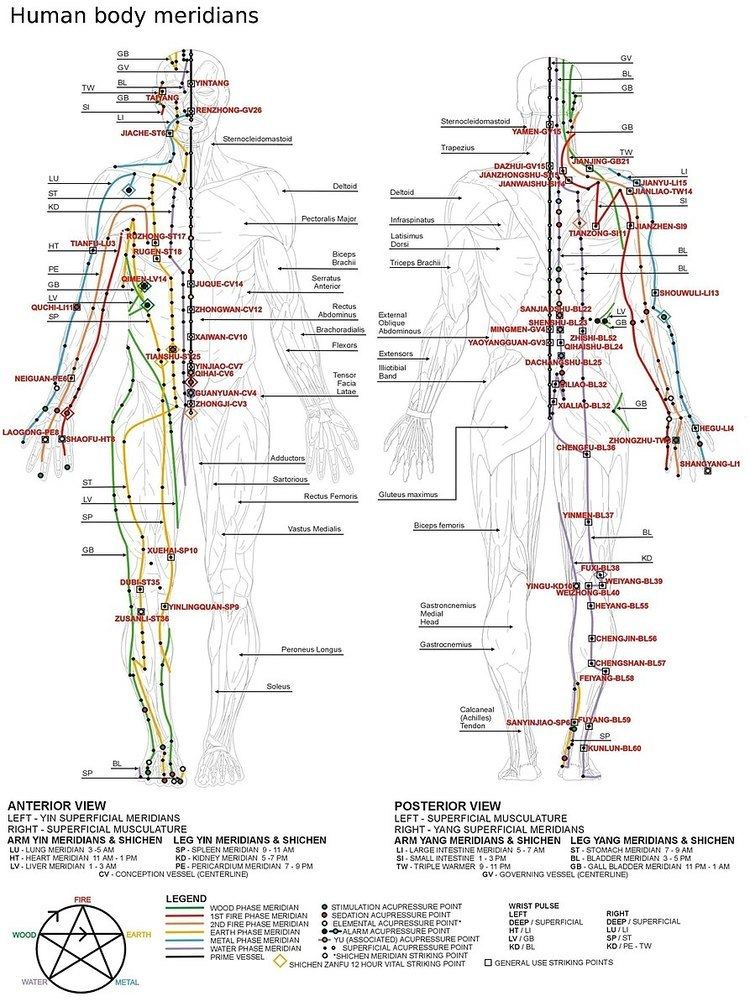 | ||
The meridian system (simplified Chinese: 经络; traditional Chinese: 經絡; pinyin: jīngluò, also called channel network) is a concept in traditional Chinese medicine (TCM) about a path through which the life-energy known as "qi" flows.
Contents
- Main concepts
- Twelve standard meridians
- Eight extraordinary meridians
- Scientific view of traditional Chinese meridian theory
- References
Meridians are not real anatomical structures: scientists have found no evidence that supports their existence.
Main concepts
The meridian network is typically divided into 2 categories, the jingmai (經脈) or meridian channels and the luomai (絡脈) or associated vessels (sometimes called "collaterals"). The jingmai contain the 12 tendinomuscular meridians, the 12 divergent meridians, the 12 principal meridians, the 8 extraordinary vessels as well as the Huato channel, a set of bilateral points on the lower back whose discovery is attributed to the ancient physician Hua Tuo. The collaterals contain 15 major arteries that connect the 12 principal meridians in various ways, in addition to the interaction with their associated internal organs and other related internal structures. The collateral system also incorporates a branching expanse of capillary-like vessels which spread throughout the body, namely in the 12 cutaneous regions as well as emanating from each point on the principal meridians. If one counts the number of unique points on each meridian, the total comes to 361, although 365 is usually used since it coincides with the number of days in a year. Note that this method ignores the fact that the bulk of acupoints are bilateral, making the actual total 670.
There are about 400 acupuncture points (not counting bilateral points twice) most of which are situated along the major 20 pathways (i.e. 12 primary and 8 extraordinary channels). However, by the 2nd Century AD, 649 acupuncture points were recognized in China (reckoned by counting bilateral points twice). There are "Twelve Principal Meridians" where each meridian corresponds to either a hollow or solid organ; interacting with it and extending along a particular extremity (i.e. arm or leg). There are also "Eight Extraordinary Channels", two of which have their own sets of points, and the remaining ones connecting points on other channels.
Twelve standard meridians
The twelve standard meridians, also called Principal Meridians, are divided into Yin and Yang groups. The Yin meridians of the arm are Lung, Heart, and Pericardium. The Yang meridians of the arm are Large Intestine, Small Intestine, and Triple Burner. The Yin Meridians of the leg are Spleen, Kidney, and Liver. The Yang meridians of the leg are Stomach, Bladder, and Gall Bladder.
The table below gives a more systematic list of the twelve standard meridians:
Eight extraordinary meridians
The eight extraordinary meridians are of pivotal importance in the study of Qigong, T'ai chi ch'uan and Chinese alchemy. These eight extra meridians are different to the standard twelve organ meridians in that they are considered to be storage vessels or reservoirs of energy and are not associated directly with the Zang Fu, i.e. internal organs. These channels were first systematically referred to in the "Spiritual Axis" chapters 17, 21 and 62, the "Classic of Difficulties" chapters 27, 28 and 29 and the "Study of the 8 Extraordinary vessels" (Qi Jing Ba Mai Kao) by Li Shi Zhen 1578.
The eight extraordinary vessels are (奇經八脈; qí jīng bā mài):
- Conception Vessel (Ren Mai) - 任脈 [rèn mài]
- Governing Vessel (Du Mai) - 督脈 [dū mài]
- Penetrating Vessel (Chong Mai) - 衝脈 [chōng mài]
- Girdle Vessel (Dai Mai) - 帶脈 [dài mài]
- Yin linking vessel (Yin Wei Mai) - 陰維脈 [yīn wéi mài]
- Yang linking vessel (Yang Wei Mai) - 陽維脈 [yáng wéi mài]
- Yin Heel Vessel (Yin Qiao Mai) - 陰蹻脈 [yīn qiāo mài]
- Yang Heel Vessel (Yang Qiao Mai) - 陽蹻脈 [yáng qiāo mài]
Scientific view of traditional Chinese meridian theory
Meridians do not exist: scientists have found no evidence that supports their existence.
Steven Novella has written "TCM is a pre-scientific superstitious view of biology and illness, similar to the humoral theory of Galen, or the notions of any pre-scientific culture. It is strange and unscientific to treat TCM as anything else. Any individual diagnostic or treatment method within TCM should be evaluated according to standard principles of science and science-based medicine, and not given special treatment."
The National Council Against Health Fraud concluded that,
The World Health Organization has listed forty conditions for which claims of effectiveness have been made. They include acute and chronic pain, rheumatoid and osteoarthritis, muscle and nerve "difficulties", depression, smoking, eating disorders, drug "behavior problems", migraine, acne, ulcers, cancer, and constipation. Some chiropractors and psychologists have made unsubstantiated claims to improve dyslexia and learning disorders by acupressure. However, scientific evidence supporting these claims is either inadequate or nonexistent.
